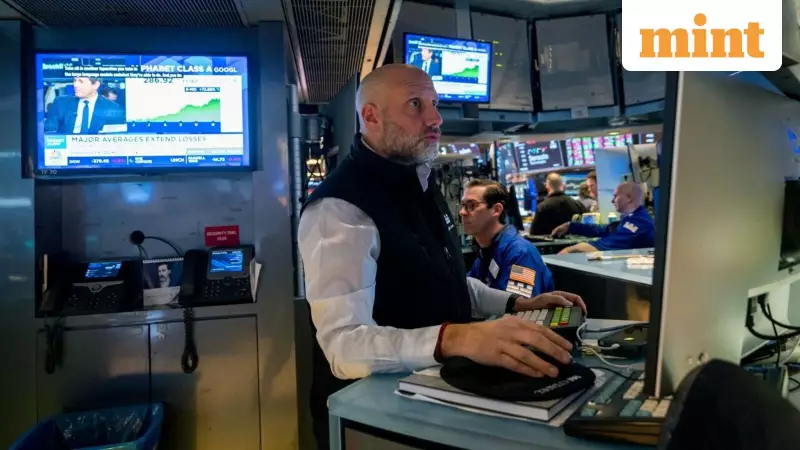
Wall Street Faces Critical Test as AI Boom Faces Scrutiny
The direction of the American economy and the future of the artificial intelligence boom are becoming clearer after a period of uncertainty. Wall Street is eagerly awaiting two crucial reports that could reshape the market outlook for the coming months, following significant tech stock volatility and the longest government shutdown in U.S. history.
Tech Stocks Volatility and Key Data Releases
Tech stocks experienced sharp declines after Tuesday's opening bell, though they managed to recover most of their losses later in the trading session. The S&P 500 fell 0.8%, while the Nasdaq retreated 1.2%. The Dow Jones Industrial Average slid 1.1%, representing approximately 500 points. This marked the blue-chip index's steepest four-day pullback from a record close since 1999.
All eyes are now on Nvidia's earnings report due after Wednesday's closing bell, which will provide crucial insights into demand for AI chips that have been central to the technology mania driving markets. Additionally, the delayed September jobs report scheduled for Thursday morning will offer fresh perspective on the labor market.
Technical Signals Suggest Deeper Concerns
Market technicians are observing warning signs beneath the surface. For the first time in 138 trading sessions, both the S&P 500 and Nasdaq composite dipped below their 50-day moving averages on Monday. This technical indicator has raised concerns among analysts who monitor such metrics for market direction clues.
"This pullback is more meaningful," stated Katie Stockton, founder of Fairlead Strategies, emphasizing that the current market behavior differs from previous fluctuations. The S&P 500 remains up 13% this year and only 4% below its recent record, but the underlying volatility suggests potential for longer-lasting market turbulence.
AI Bubble Concerns and Investor Sentiment
The recent selloff in Nvidia has significantly impacted market indexes, with several major funds including Peter Thiel's macro hedge fund reducing their positions. The ripple effects have extended beyond AI-related stocks into cryptocurrencies, gold, and other assets.
According to a Bank of America survey conducted in November, 45% of fund managers now consider an AI bubble as the top tail risk for markets, a substantial increase from 11% in September. More than half of investors believe AI stocks are already in a bubble territory.
"We're starting to see that yes, there are [AI] revenues, but there are also massive costs," noted Joy Yang, head of product management at MarketVector Indexes. "You don't become a four- or five-trillion-dollar company in this amount of time without some kind of readjustment."
The scale of investment in AI infrastructure is staggering. Five leading data-center hyperscalers—Meta, Oracle, Alphabet, Microsoft and Amazon—invested a combined $106 billion into capital expenditures during their most recent quarters, according to Dow Jones Market Data.
Nvidia's High-Stakes Earnings Report
Nvidia's earnings have evolved into a quarterly barometer of market confidence in the AI sector, complete with watch parties and social media discussions. Historically, even strong financial results coupled with improved outlooks haven't always satisfied investors, with shares sometimes declining initially before recovering.
Options traders are anticipating substantial movement in Nvidia stock following the earnings announcement. Market data indicates traders are positioning for an approximately 8% swing in either direction after the results through Friday. On Tuesday, the most actively traded Nvidia options contracts were those betting on the stock reaching $195 or $200, while shares closed at $181.36.
"Anything less than a stellar report and outlook could make stock indexes vulnerable," warned James Demmert, chief investment officer of Main Street Research. However, he noted that Nvidia's 10% decline over the past month might mean the stock faces slightly lower expectations post-earnings.
Labor Market Insights and Federal Reserve Implications
The September jobs report will provide critical information about whether the increasingly divided Federal Reserve might cut interest rates next month. While traders have reduced their expectations for a December rate cut, futures markets still indicate a more than two-thirds probability of a cut by January.
Bond yields and oil prices have remained relatively stable during the recent stock market decline, suggesting that fears of an immediate recession might be contained. However, slowing job growth combined with persistent inflation has contributed to some of the worst recorded levels of American consumer sentiment.
"Fundamentally, there are still good reasons to believe that wealthier households should continue to perform pretty well," commented Ben May, director of global macro research at Oxford Economics. "In the end, they dominate in terms of spending over the lower-income households."
Mark Hackett, chief market strategist at Nationwide, summarized the current investor sentiment: "The fact that there's so much fog or lack of transparency—the easiest thing for investors to do is move to the sidelines. That's where you get this emotion and volatility. It's not because they have everything figured out; it's because they don't."
This week's dual data releases will prove crucial in determining whether the recent market pullback represents a healthy pause in the ongoing rally or signals the beginning of a more significant downturn.





